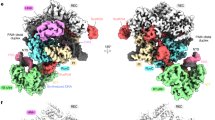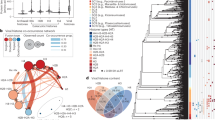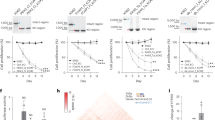Abstract
EXTENSIVE DNA sequence analysis of the cloned histone gene repeat unit from the sea urchin Stronglyocentrotus purpuratus has identified the five histone protein coding sequences1–3 (I.S., unpublished). R-loop and heteroduplex mapping strongly suggest that the sea urchin histone genes contain no intervening sequences4. In addition to the protein coding sequences the corresponding histone mRNAs each contain about 100 extra nucleotides4,5. The location of these additional sequences in relation to the coding sequences is not certain. It is of interest to map the mRNA termini within the known DNA sequence because this information may help to identify transcriptional and translational control elements. Direct nucleotide sequence analysis of RNA can be carried out by enzymatic, base-specific cleavage of end-labelled RNAs6,7. However, 5′-end labelling of mRNAs involves several enzymatic reactions (‘decapping’, dephosphorylation and phosphorylation) that require nuclease-free enzyme preparations8; furthermore, the RNA to be sequenced must be homogeneous. Indirect sequencing analysis of RNA can be obtained from its complementary cDNA. RNA has been sequenced in this way using a chain termination method with dideoxytriphosphates9, synthetic primers and purified mRNA templates10–12. Alternatively, end-labelled restriction fragments have been used to prime synthesis of cDNA on homogeneous 13,14 and partially purified15,16 mRNA templates followed by either chemical17 or enzymatic9 sequencing of the resulting cDNA. Our approach is similar and shows that prior purification of the RNA template is unnecessary. We present here the 5′-terminal sequence of S. purpuratus H2b mRNA, derived from purified H2b mRNA as well as from total polysomal RNA, using the chain termination method9 adapted for RNA sequencing. We also determine its location within the histone DNA sequence.
This is a preview of subscription content, access via your institution
Access options
Subscribe to this journal
Receive 51 print issues and online access
$199.00 per year
only $3.90 per issue
Buy this article
- Purchase on Springer Link
- Instant access to full article PDF
Prices may be subject to local taxes which are calculated during checkout
Similar content being viewed by others
References
Sures, I., Maxam, A., Cohn, R. H. & Kedes, L. H. Cell 9, 495–502 (1976).
Grunstein, M. & Grunstein, J. E. Cold Spring Harb. Symp. quant. Biol. 42, 1083–1092 (1977).
Sures, I., Lowry, J. & Kedes, L. H. Cell 15, 1033–1044 (1978).
Holmes, D. S., Cohn, R. H., Kedes, L. H. & Davidson, N. Biochemistry 16, 1504–1511 (1977).
Cohn, R. H., Lowry, J. C. & Kedes, L. H. Cell 9, 147–161 (1976).
Donis-Keller, H., Maxam, A. M. & Gilbert, W. Nucleic Acid Res. 4, 2527–2538 (1977).
England, T. E. & Uhlenbeck, O. C. Nature 275, 560–561 (1978).
Efstratiadis, A. et al. Nucleic Acid Res. 4, 4165–4174 (1977).
Sanger, F., Nicklen, S. & Coulson, A. R. Proc. natn. Acad. Sci. U.S.A. 74, 5463–5467 (1977).
Zimmern, D. & Kaesberg, P. Proc. natn. Acad. Sci. U.S.A. 75, 4257–4261 (1978).
Hamlyn, P. H., Brownlee, G. G., Cheng, C. C., Gait, M. J. & Milstein, C. Cell 15, 1067–1075 (1978).
McGeoch, D. J. & Turnbull, N. T. Nucleic Acid Res. 5, 4007–4024 (1978).
McReynolds, L. et al. Nature 273, 723–728 (1978).
Akusjärvi, G. & Pettersson, U. Proc. natn. Acad. Sci. U.S.A. 75, 5822–5826 (1978).
Bina-Stein, M., Thoren, M., Salzman, N. & Thompson, A. Proc. natn. Acad. Sci. U.S.A. 76, 731–735 (1979).
Ghosh, P. K. et al. J. biol. Chem. 253, 3643–3647 (1978).
Maxam, A. M. & Gilbert, W. Proc. natn. Acad. Sci. U.S.A. 74, 560–564 (1977).
Casey, J. & Davidson, N. Nucleic Acid Res. 4, 1539–1552 (1977).
Szalay, A. A., Grohmann, K. & Sinsheimer, R. L. Nucleic Acid Res. 4, 1569–1578 (1977).
Maxam, A. M. & Gilbert, W. Meth. Enzym. (in the presss).
Childs, G., Levy, S. & Kedes, L. H. Biochemistry 18, 208–213 (1979).
Sanger, F. & Coulson, A. R. FEBS Lett. 87, 107–110 (1978).
Surrey, S. & Nemer, M. Cell 9, 589–595 (1976).
Author information
Authors and Affiliations
Rights and permissions
About this article
Cite this article
LEVY, S., SURES, I. & KEDES, L. Sequence of the 5′-end of Strongylocentrotus purpuratus H2b histone mRNA and its location within histone DNA. Nature 279, 737–739 (1979). https://doi.org/10.1038/279737a0
Received:
Accepted:
Issue Date:
DOI: https://doi.org/10.1038/279737a0
This article is cited by
Comments
By submitting a comment you agree to abide by our Terms and Community Guidelines. If you find something abusive or that does not comply with our terms or guidelines please flag it as inappropriate.



